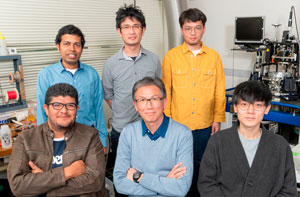Sep. 4, 2020 Research Highlight Physics / Astronomy
Using two acoustic reflectors triples spin-current generation
Reflecting sound waves back toward a layered component triples the amount of spin current it produces
 Figure 1: Placing a component consisting of nickel, copper and bismuth oxide layers (top image) between two interdigital transducers (IDTs) that produce high-frequency sound waves generates a spin current in the copper layer. But this setup wastes half the sound waves. Inserting the setup between two acoustic reflectors recovers the lost sound waves and triples the spin current obtained.© 2020 RIKEN Center for Emergent Matter Science
Figure 1: Placing a component consisting of nickel, copper and bismuth oxide layers (top image) between two interdigital transducers (IDTs) that produce high-frequency sound waves generates a spin current in the copper layer. But this setup wastes half the sound waves. Inserting the setup between two acoustic reflectors recovers the lost sound waves and triples the spin current obtained.© 2020 RIKEN Center for Emergent Matter Science
More-efficient memory-storage devices are one potential application of a discovery by RIKEN physicists of a convenient way to enhance the output of a device that converts sound waves into a flow of electron spins1.
Conventional electronic devices operate by shunting electrons along wires. The unwanted heat generated by this process both wastes energy and limits how densely components can be packed together in devices.
In contrast, spintronic devices are based on spin current—the flow of the spins (angular momenta) of electrons. Since this does not involve the physical movement of electrons, spintronic devices promise to be much more energy efficient than their electronic counterparts. They will also be smaller since more components can be packed into the same space.
One way to generate a spin current is to use sound waves—exciting high-frequency sound waves on the surface of a ferromagnetic material such as iron or nickel generates spin currents into non-magnetic layers above the ferromagnetic material.
But this process wastes half of the acoustic energy since the three-layer stack is sandwiched between two sound-wave generators that produce sound waves in two directions. Thus, the sound waves that travel away from the three-layer stack are lost.
 Jorge Puebla (bottom left), Yoshichika Otani (bottom center), who is team leader of the Quantum Nano-scale Magnetism Team the RIKEN CEMS, Yunyoung Hwang (bottom right) and co-workers have used an acoustic cavity to enhance spin current generation by spin pumping.© 2020 RIKEN
Jorge Puebla (bottom left), Yoshichika Otani (bottom center), who is team leader of the Quantum Nano-scale Magnetism Team the RIKEN CEMS, Yunyoung Hwang (bottom right) and co-workers have used an acoustic cavity to enhance spin current generation by spin pumping.© 2020 RIKEN
Now, Jorge Puebla of the RIKEN Center for Emergent Matter Science, Yunyoung Hwang of the University of Tokyo, and four co-workers have solved this problem by placing the whole setup between two acoustic ‘mirrors’ that reflect sound waves heading in the wrong direction back toward the three-layer stack (Fig. 1).
Because this arrangement doubles the acoustic energy that reaches the three-layer stack, the team was expecting to double the spin current. But they got more spin current than they had bargained for—they observed a threefold increase. The researchers are unsure where this extra gain in spin current is coming from. “The threefold enhancement came as a surprise to us and to be honest we don’t really understand where it is coming from,” says Puebla. “It’s a nice problem to have, but it’s still a bit of mystery. We’re looking into it now.”
The method could help realize memory-storage devices that have low-power requirements. “One of the main applications of spin currents is using them to store data by flipping the magnetization direction of a magnetic material,” explains Puebla. “But the spin current needs to be large enough to do this, and so that is one of our motivations for boosting the spin current.”
Related contents
- Using spin current to convert mechanical vibrations into electricity
- Scientists develop principles for the creation of an “acoustic diode”
- Sound waves create skyrmions in a magnetic film
References
- 1. Hwang, Y., Puebla, J., Xu, M., Lagarrigue, A., Kondou, K. & Otani, Y. Enhancement of acoustic spin pumping by acoustic distributed Bragg reflector cavity. Applied Physics Letters 116, 252404 (2020) (Editor’s Pick). doi: 10.1063/5.0011799
